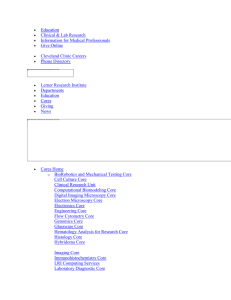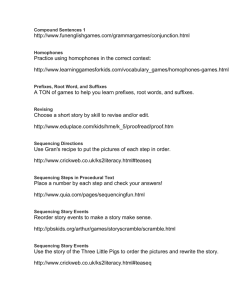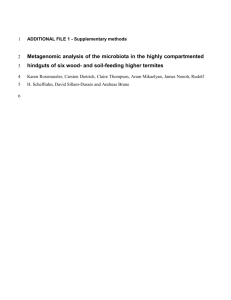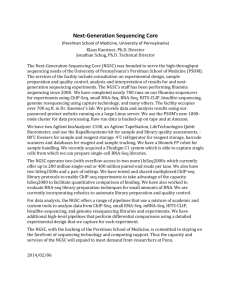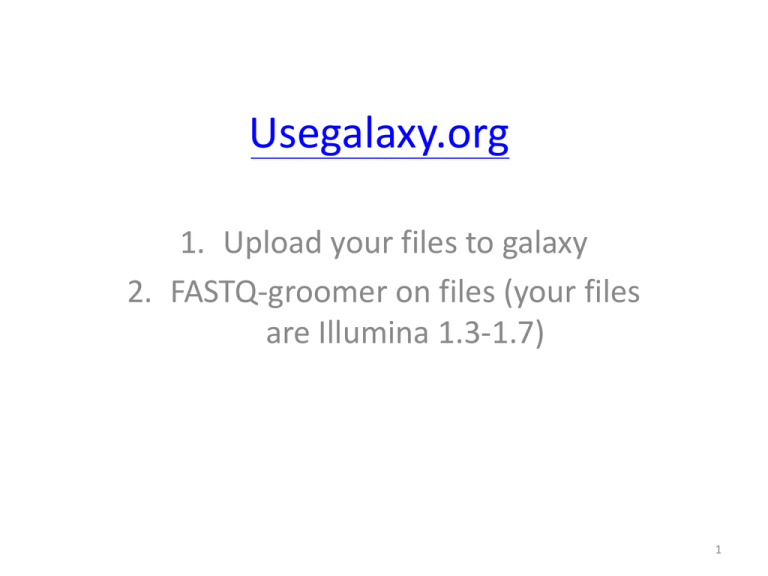
Usegalaxy.org
1. Upload your files to galaxy
2. FASTQ-groomer on files (your files
are Illumina 1.3-1.7)
1
What you know: Sanger Sequencing
Fluorescent dye-terminator sequencing
(90s – today)
© source unknown. All rights reserved. This content is excluded
from our Creative Commons license. For more information, see
http://ocw.mit.edu/help/faq-fair-use/.
© source unknown. All rights reserved.
This content is excluded from our
Creative Commons license. For more
For more information, see
http://ocw.mit.edu/help/faq-fair-use/.
Traditional sanger / chain
termination methods
Radioactive slab gels.
(70s,80s,90s)
4 separate lanes, 1 per base
How does this work?
What is the data like? How long?
How much money (per base)?
Image from the National Library
of Medicine, public domain.
Fred Sanger
Nobel laureate 1958,1980
Length: 500-1000bp
Data is bad at beginning and end of read
~cents per base
2
“Next Gen Sequencing”
• All the sequences technologies since Sanger
sequencing.
• Many sequencing technologies, but one is
hugely dominant.
https://www.illumina.com/
http://allseq.com/knowledgebank
For modern-ish review of other
sequencing platforms
*we used Illumina sequencing for
our RNA-Seq experiment
3
How does Illumina sequencing work?
• Massively parallel sequencing of short reads – 40bp-300bp
© Massey University. All rights reserved. This content is excluded from our Creative
Commons license. For more information, see http://ocw.mit.edu/help/faq-fair-use/.
Image of Illumina HiSeq flowcell
Every spot (cluster) on the flowcell is a unique sequencing reaction.
Each spot is 1um or less.
A bit outdated, but detailed resource on Illumina sequencing:
https://www.broadinstitute.org/scientific-community/science/platforms/genomesequencing/broadillumina-genome-analyzer-boot-camp
4
Illumina HiSeq2500 flowcell photograph removed due to copyright restrictions.
Please see: http://www.cisd.ethz.ch/software/openBIS/Deep_Sequencing;
Illumina Flow Cell v3: http://www.cisd.ethz.ch/software/openBIS/Deep_Sequencing
/Illumina_Flow_Cell_v3.jpg?hires
Illumina HiSeq2500 flowcell
Sequencing happens on a flowcell, you buy sequencing capacity by lane (the
flowcell above has 8)
Each lane gives you 200M + reads, and costs upwards of $1000
5
Illumina / Solexa Sequencing
© Massey University. All rights reserved. This content is excluded
from our Creative Commons license. For more information, see
http://ocw.mit.edu/help/faq-fair-use/.
1 base per cycle.
~1 hour per cycle (20mins
chemistry, 40mins imaging)
~1000 molecules per cluster
<1um per cluster
*varies somewhat depending on
Illumina instrument
Reprinted by permission from Macmillan Publishers Ltd: Nature Review Genetics.
Source: Metzker, M. L. "Sequencing Technologies — the Next Generation." Nature Reviews Genetics 11 (2010): 31–46. © 2010.
6
Movie on Illumina sequencing
https://www.youtube.com/watch?v=womKfikWlxM
7
How to get DNA suitable for
sequencing? Library Prep
Depending on what type of library
prep you do, can have totally
different types of experiments (DNA,
RNA, methylation, ribosome
profiling)
But ultimately, everything looks the
same when it is converted to the
final flowcell ready fragment: a
dsDNA fragment with asymmetric
adaptors
Reprinted by permission from Macmillan Publishers Ltd: 1DWXUH5HYLHZ*HQHWLFV.
Nature
Source: Wang, Z., Gerstein, M., et al. "RNA-Seq: A Rvolutionary
ToolReviews
for | Genetics
Transcriptomics." 1DWXUH5HYLHZV*HQHWLFV 10 ( 2009): 57–63. © 2009.
8
Anatomy of an Illumina sequencing fragment
- P5 & P7 oligos bind fragment to flowcell
Can have single ended sequencing. Only Read 1 (plus index read if
multiplexing/barcoding)
- Paired end sequencing. Read 1&2 (plus index read)
- Index read gives you the multiplexing / barcoding that lets you put multiple
samples onto the same “lane”
9
Whats the data like - FASTQ
@WIGTC-HISEQ:4:1107:1232:1988#TTAGGC/1;0
TGAAACTATTTTCACCCAGACAGATGCCATATTTGAATTC
+WIGTC-HISEQ:4:1107:1232:1988#TTAGGC/1;0
]\Z``RS\_baaS^__bPR_J^V\\[VbR[\[_aSI^V^B
@WIGTC-HISEQ:4:1107:1117:1992#TTAGGC/1;1
GTGGGGATGTTCGACTGGATTCATGGCAACTCCTCTGACA
+WIGTC-HISEQ:4:1107:1117:1992#TTAGGC/1;1
___eeeecgbeeefghffhiffiiiifhhhbghhhhfhfb
@WIGTC-HISEQ:4:1107:1647:1958#TTAGGC/1;1
CTGTAATTGGCTTCCGACGACTTGGAATGATAGCATCGAA
+WIGTC-HISEQ:4:1107:1647:1958#TTAGGC/1;1
\__S`cdeffeggfghfihhihiiifghbffhihfhhfgh
@WIGTC-HISEQ:4:1107:1629:1991#TTAGGC/1;1
GGCAACAGCGGTCTTGGAGACGGCAGCAGCGGTACCTCCT
+WIGTC-HISEQ:4:1107:1629:1991#TTAGGC/1;1
__bJ`cdeffceghhhihiffdghgghhihfdUedgibg ]
@WIGTC-HISEQ:4:1107:1516:1994#TTAGGC/1;1
GTCCATCGAGCCATGGGGTCTTGACTGTGGTGATGAAGAA
+WIGTC-HISEQ:4:1107:1516:1994#TTAGGC/1;1
_abeeeeeggfggiiiiicfhihihiihhiegbgffhhhi
@WIGTC-HISEQ:4:1107:2130:1974#TTAGGC/1;1
GTCCGTCGTTTCCTGGTGCTCCTGGTTGTCCATCAGCTCC
+WIGTC-HISEQ:4:1107:2130:1974#TTAGGC/1;1
bb_ceeeegfggghiiffgihhhfighhihfhfiihhiii
@WIGTC-HISEQ:4:1107:2078:1977#TTAGGC/1;1
ATGGAGTTGTCTCAAACGTCTGCACGATCTCCTTCACGAT
+WIGTC-HISEQ:4:1107:2078:1977#TTAGGC/1;1
bbbeeedeggggghiiiifgiiiiiihiiiiiiiiiihhh
Orange -> Sequence data
Line 1: Read identifying metadata
@WIGTC-HISEQ -> Instrument name
4 -> Flowcell lane #4
1107:1117:1992 -> X,Y and tile #
#TTAGGC -> Barcode
/1 -> Forward read (/2 is reverse read)
Line 2:
ATCG… The actual nucleotide sequence data
Blue -> Quality data
Line 3: Read identifying metadata (same as line 1)
Line 4: Quality data. 1 character per base.
http://en.wikipedia.org/wiki/FASTQ_format
Quality data can be in different encodings!
Check encoding of a given FASTQ file with the
FastQC program (on galaxy and standalone)
FASTQ groomer on Galaxy can convert quality score
10
encodings
RNA-seq in a nutshell
1. Start with raw reads: FASTQ
2. Some quality filtering, dropping
bad reads, removing or trimming
reads include sequence from
adaptors
3. “Map” to a reference genome
using a splice-junction-aware
mapper/sequence aligner. TopHat is
commonly used. Produces .bam file.
4. Count how many reads map to a
given gene. That count is
proportional to the abundance of
that transcript in the original sample.
Cuffdiff of the Cufflinks suite can do
this. Produces a spreadsheet.
© source unknown. All rights reserved. This content is excluded
From our Creative Commons license. For more information, see
http://ocw.mit.edu/help/faq-fair-use/.
11
Tools on Galaxy you should know
about
• *Reminder that Galaxy is mainly a wrapper
around existing command-line programs.
• NGS: QC and manipulation -> FastQC
– Give it a FASTQ, bam, or sam file, and it computes
summary statistics to help evaluate if your sequencing
run worked, or just how the reads along the process
look globally.
• NGS: QC and manipulation -> FASTQ Groomer
– Converts FASTQ quality encoding to something Galaxy
likes (“Sanger” format). FastQC can tell you what the
quality encoding is for a given FASTQ file.
12
More Galaxy tools
• Bowtie & Bowtie2 -> Genome mapper for
fragments
• TopHat -> Splice junction aware mapper. Use
for mapping RNA reads to a genome
• Cufflinks suite -> Suite of tools for doing
expression analysis (and other things) on RNASeq data (Trapnell et al. 2012) - http://coletrapnell-lab.github.io/cufflinks/
Trapnell, C., Roberts, A., Goff, L., Pertea, G., Kim, D., Kelley, D.R., Pimentel, H., Salzberg, S.L., Rinn, J.L., and
Pachter, L. (2012). Differential gene and transcript expression analysis of RNA-seq experiments with TopHat and
Cufflinks. Nat. Protocols 7, 562–78.
13
MIT OpenCourseWare
http://ocw.mit.edu
7.15 Experimental Molecular Genetics
Spring 2015
For information about citing these materials or our Terms of Use, visit: http://ocw.mit.edu/terms.

